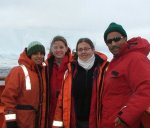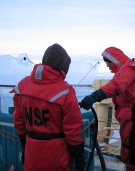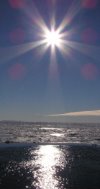Incubators in the emergency ward

Photo: Freezing incubators
We reach the station full of plans and enthusiasm only to be met by a gray sky and temperatures dipping to almost -50oC. By nightfall the techs alert us to a major problem. The pumps that draw seawater into our huge Plexi glass incubators and thus maintain water temperatures are sucking ice and slush, and our incubators could freeze and break.
The entire contingent goes on hourly 'ice watch' duty. This means scraping ice off the huge tanks and keeping the water flowing. But the tanks are outside on the deck so it also means braving -50oC temperatures, nasty winds and hands in freezing water at 2 am.

I am totally useless – my arms aren’t strong enough to scrape the monstrous tanks some of which are standing 4 feet off the ground, my plumbing skills are nonexistent so I can't figure out which pipes to connect or disconnect. I am left holding a hair drier in my hand. Then I get hold of a butterfly net and sieve the large chunks of ice from the tank. At least now I look busy.
Everywhere I hear 'Get this one' or 'We are losing that one' -- its like being in an emergency ward after a disaster. Not even the emperor penguins dozing off on a floe can cheer the sleep-deprived scientists.

Photo: Watching over freezing incubators
By day, the sun melts a bit of the ice and we are given respite from 'ice watch'. No one can figure out what to do.
Then fortune smiles on us -– this station has no phytoplankton, the little photosynthetic organisms we are looking for. We are too early in the season. Phytoplankton need to be in the upper well lit portion of the water column so they can photosynthesize, grow and supply food to the rest of the food chain.

Photo: Midnight sun in Antarctica
With strong winds, the water is being churned and they are being buffeted all over the water column. It's not the best of situations when you are a microscopic creature with no motion of your own. We move on to greener pastures.

0 Comments:
Post a Comment
<< Home